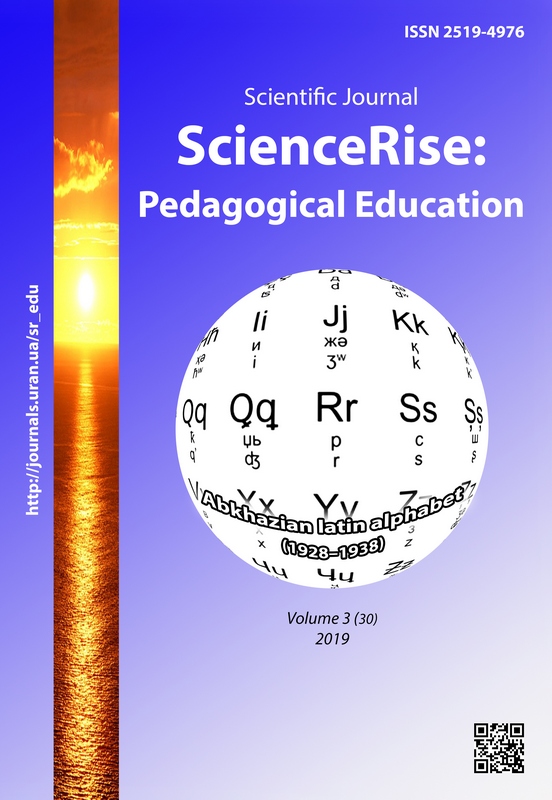Information-communication technologies as the instrument for improving the quality of the educational process
DOI:
https://doi.org/10.15587/2519-4984.2019.170269Keywords:
educational environment, innovative tools, educational process quality, electronic resources, competencesAbstract
Now, different innovative technologies are used to improve the educational process through the presentation of a modern learning content, the quality monitoring and evaluation of learning results at the various stages, and also the creation of new organizational forms of learning, educational and scientific resources and electronic systems and their implementation in the process of students’ self-study and their classroom study. The transformation of the educational environment of the educational institutions by the use of special platforms is an important trend of the modern research. As the electronic educational resources supports different types of learning and research activities, such as theoretical material studies, the search for useful information, task solutions, testing, training, simulation, making experiments and others. Besides in the national strategy of education development takes place a defined course to improve the competitiveness and quality of education to ensure public high-level professionals in the current socio-economic conditions, and integration into the European and world educational space and precisely for this reason one of the main strategic directions of the national education system is the widespread integration of information technologies and innovative educational programs. The article is devoted to an analysis of the problems of modernization of the educational environment in the context of improving and quality control of information and communication technologies and innovative tools adoption into the educational process. Based on analysis of scientific researches in this field and according to the definition of quality of an educational process by UNESCO criteria, there was affected the question concerning monitoring systems of functioning of a higher educational institution as a unit that is its economic, administrative and educational guide. An analysis of impacts that must be factored now into our educational system is made. The most important indicators of information educational environment are considered. The main factors of the level of formation of educational-research environment have been given. The perspectives of using the electronic resources in the system of higher education are revealed
References
- Bykov, V. Yu. (2008). Models of the open education organizational systems. Kyiv: Atika, 684.
- Natsionalna stratehiia rozvytku osvity v Ukraini na 2012–2021 roky. Available at: http://zakon0.rada.gov.ua/laws/show/344/2013
- Shyshkina, M. (2013). Emerging Technologies for Training of ICT-Skilled Educational Personnel. Communications in Computer and Information Science. Vol. 412. Berlin-Heidelberg: Springer-Verlag, 274–284. doi: http://doi.org/10.1007/978-3-319-03998-5_14
- Shyshkina, M. (2013). Innovative Technologies for Development of Learning Research Space of Educational Institution. Information Technologies and Society, 16 (1), 599–608.
- Bykov, V. Y. (2011). Technologies of cloud computing, ict-outsourcing and new functions of ict-departments of educational and scientific institutions. Information Technologies in Education, 10, 8–23. doi: http://doi.org/10.14308/ite000260
- Shyshkina, M. (2015). The Hybrid Service Model of Electronic Resources Access in the Cloud-Based Learning Environment. Integration, Harmonization and Knowledge Transfer, 1356, 295–310.
- Lakshminarayanan, R., Kumar, B., Raju, M. (2013). Cloud Computing Benefits for Educational Institutions. Second International Conference of the Omani Society for Educational Technology. Muscat: Cornell University Library. Available at: http://arxiv.org/ftp/arxiv/papers/1305/1305.2616.pdf
- Mell, P., Grance, T. (2011). The NIST Definition of Cloud Computing. Recommendations of the National Institute of Standards and Technology. NIST. doi: http://doi.org/10.6028/nist.sp.800-145
- Bard, G. V. (2015). Sage for Undergraduates. AMS, 352. doi: http://doi.org/10.1090/mbk/087
- Doelitzscher, F., Sulistio, A., Reich, C., Kuijs, H., Wolf, D. (2010). Private cloud for collaboration and e-Learning services: from IaaS to SaaS. Computing, 91 (1), 23–42. doi: http://doi.org/10.1007/s00607-010-0106-z
- Wick, D. (2009). Free and open-source software applications for mathematics and education. Proceedings of the twenty-first annual international conference on technology in collegiate mathematics, 300–304.
- Bittman, T. (2008). Cloud Computing and K-12 Education. Available at: https://blogs.gartner.com/thomas_bittman/2008/11/26/cloud-computing-and-k-12-education/
- Zelenska, O., Silichova, T., Stiepanova, K. (2018). Some peculiarities and issues of monitoring learning process at higher educational institutions. Theoretical questions of culture, education and upbringing, 1 (57), 62–69.
- Stiepanova, K., Afanaseva, L. (2019). The problem of monitoring the quality of the educational process. Cycles Economic Development (CED – 2019). Kharkiv, 407–409.
- Donnelly, R., McSweeney, F. (2008). Applied E-Learning and E-Teaching in Higher Education. Hershey: New York, 440. doi: http://doi.org/10.4018/978-1-59904-814-7
Downloads
Published
How to Cite
Issue
Section
License
Copyright (c) 2019 Kateryna Stiepanova

This work is licensed under a Creative Commons Attribution 4.0 International License.
Our journal abides by the Creative Commons CC BY copyright rights and permissions for open access journals.
Authors, who are published in this journal, agree to the following conditions:
1. The authors reserve the right to authorship of the work and pass the first publication right of this work to the journal under the terms of a Creative Commons CC BY, which allows others to freely distribute the published research with the obligatory reference to the authors of the original work and the first publication of the work in this journal.
2. The authors have the right to conclude separate supplement agreements that relate to non-exclusive work distribution in the form in which it has been published by the journal (for example, to upload the work to the online storage of the journal or publish it as part of a monograph), provided that the reference to the first publication of the work in this journal is included.








